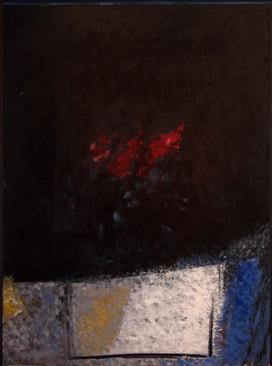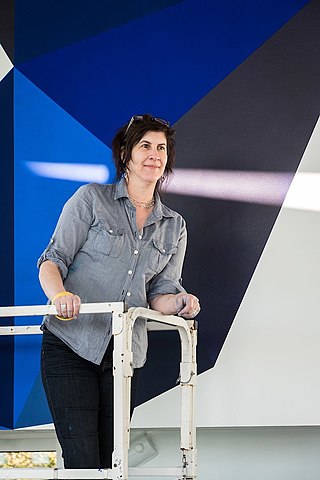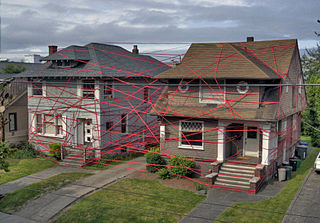Related Research Articles

Dale Chihuly is an American glass artist and entrepreneur. He is well known in the field of blown glass, "moving it into the realm of large-scale sculpture".

The Henry Art Gallery is a contemporary art museum located on the University of Washington campus in Seattle, Washington. Located on the west edge of the university's campus along 15th Avenue N.E. in the University District, it was founded in February, 1927, and was the first public art museum in the state of Washington. The original building was designed by Bebb and Gould. It was expanded in 1997 to 40,000 square feet (3,700 m2), at which time the 154-seat auditorium was added. The addition/expansion was designed by Gwathmey Siegel & Associates Architects.

Michael Heizer is an American land artist specializing in large-scale and site-specific sculptures. Working largely outside the confines of the traditional art spaces of galleries and museums, Heizer has redefined sculpture in terms of size, mass, gesture, and process. A pioneer of 20th-century land art or Earthworks movement, he is widely recognized for sculptures and environmental structures made with earth-moving equipment, which he began creating in the American West in 1967. He currently lives and works in Hiko, Nevada, and New York City.

Counterfeit money is currency produced without the legal sanction of a state or government, usually in a deliberate attempt to imitate that currency and so as to deceive its recipient. Producing or using counterfeit money is a form of fraud or forgery, and is illegal. The business of counterfeiting money is nearly as old as money itself: plated copies have been found of Lydian coins, which are thought to be among the first Western coins. Before the introduction of paper money, the most prevalent method of counterfeiting involved mixing base metals with pure gold or silver. Another form of counterfeiting is the production of documents by legitimate printers in response to fraudulent instructions. During World War II, the Nazis forged British pounds and American dollars. Today some of the finest counterfeit banknotes are called Superdollars because of their high quality and imitation of the real US dollar. There has been significant counterfeiting of Euro banknotes and coins since the launch of the currency in 2002, but considerably less than that of the US dollar.

The Olympic Sculpture Park, created and operated by the Seattle Art Museum (SAM), is a public park with modern and contemporary sculpture in downtown Seattle, Washington, United States. The park, which opened January 20, 2007, consists of a 9-acre (36,000 m2) outdoor sculpture museum, an indoor pavilion, and a beach on Puget Sound. It is situated in Belltown at the northern end of the Central Waterfront and the southern end of Myrtle Edwards Park.
Laura Fritz, is a Portland, Oregon based installation artist who incorporates sculpture, light and video.

Mary Lee Hu is an American artist, goldsmith, and college level educator known for using textile techniques to create intricate woven wire jewelry.
Charles Stokes (1944–2008) was a painter and sculptor and a prominent member of the last generation of artists identified with the Northwest School. He was the first winner of the prestigious Betty Bowen Award in concert with the Seattle Art Museum in 1979. His works are held by Northwest museums and institutions, most prominently the Museum of Northwest Art in La Conner, Washington, and by numerous private collectors. Revered as an energetic, charismatic, original, and meticulous artist and teacher, he spent his final two decades in self-imposed isolation from the art world producing works seen only by intimates. Stokes was born in Tacoma, Washington. He lived and worked in the Northwest until the early 1990s, when he settled in Manhattan, New York City.
Gary Lee Noffke is an American artist and metalsmith. Known for versatility and originality, he is a blacksmith, coppersmith, silversmith, goldsmith, and toolmaker. He has produced gold and silver hollowware, cutlery, jewelry, and forged steelware. Noffke is noted for his technical versatility, his pioneering research into hot forging, the introduction of new alloys, and his ability to both build on and challenge traditional techniques. He has been called the metalsmith's metalsmith, a pacesetter, and a maverick. He is also an educator who has mentored an entire generation of metalsmiths. He has received numerous awards and honors. He has exhibited internationally, and his work is represented in collections around the world.

Jay Steensma (1941–1994), also known as J. Steensma, was an American artist, primarily a painter, sometimes described by reviewers as a later-day exponent of the Northwest School of artists. He was known for his extremely prolific output, and, at times, unusual media. Chalices, snakes, houses, clouds, birds, and fish were frequent subjects in his work. He was one of the more successful artists in the Pacific Northwest in the 1980s and 90s, but had longstanding health problems, and died in Seattle at age 52.

William Ivey was an American abstract expressionist painter, sometimes associated with the Northwest School of artists. After stints in the US Army and studying art in California, he spent most of his career in Seattle, Washington. Seattle Times critic Deloris Tarzan Ament described him as "the Dean of Northwest Painters".
Patti Warashina is an American artist known for her imaginative ceramic sculptures. Often constructing her sculptures using porcelain, Warashina creates narrative and figurative art. Her works are in the collection of the Museum of Arts and Design, New York, National Museum of Modern Art, Kyoto, and the Smithsonian American Art Museum.

Victoria Haven is an American artist known for her investigative drawing practices which often operate in the spaces between two and three dimensions. Using materials as varied as tape, rubber-bands, Gore-Tex, forged steel, and excavated building components, her work traces the corridors of real and imagined space. Critics say her "geometric abstractions...draw connections between landscape, history, and lived experience" with her work Blue Sun echoing the "weight and volume [of] the Olympic Mountain range" of Washington State. The artist says Blue Sun was inspired by time-lapse video of demolition and reconstruction in Seattle's South Lake Union neighborhood.
Lynne Woods Turner is an American contemporary abstract painter. She holds a B.A. from Stephens College, Columbia, MO and an M.F.A. from University of Iowa, Iowa City. Stephanie Snyder, curator at the Cooley Gallery at Reed College, describes her work as having "emerge(d) through the artist's passionate exploration of mathematical relationships, natural phenomena, and the visceral responses of the human body." She shows at Greg Kucera Gallery Inc., Seattle, Danese/Corey, New York, and Gallery Joe, Philadelphia. Her work is in numerous public art collections including the MOMA Collection, the Judith Rothschild Foundation and the Fogg Art Museum, Harvard University, and the National Gallery of Art.

SuttonBeresCuller is a Seattle-based art collective who create sculpture, drawing, site-specific installation and public art environments. The artists, John Sutton, Ben Beres and Zac Culler have been working collaboratively since graduating from Cornish College of the Arts in Seattle, WA in 2000.
Ross Palmer Beecher is a contemporary mixed media artist who creates "quilts, flags, portraits of famous film directors and American folk heroes, and other types of objects from aluminum cans and found objects". She lives and works in Seattle.

Helen O'Toole is an Irish-born painter based in the United States, who is known for abstract paintings suggestive of landscape. She has exhibited throughout Ireland and the United States, in Singapore, and at venues including the San Francisco Museum of Modern Art, Portland Art Museum, Chicago Cultural Center, Tacoma Art Museum, and Institute of Contemporary Arts Singapore. Her work has been featured in the journals Artforum, Arts Magazine, New Art Examiner, and Zyzzyva, as well as the Chicago Tribune,The Irish Times, Seattle Post-Intelligencer, and National Public Radio. Art writers frequently discuss the interplay in her work between abstraction, the evocation of otherworldly light, land and space, and a commitment to investigating meaning through a painting process akin to the processes of cultivation and excavation. Artforum critic James Yood wrote, "echoing the often inchoate quality of nature, her paint surges toward mystery and hints at a kind of chiaroscuro of the spirit"; curator Bonnie Laing-Malcomson suggests her "richly colored monumental paintings evoke the moody landscape of her rural Irish homeland, summoning the force of J. M. W. Turner and Mark Rothko." She has been recognized with a Guggenheim Fellowship in Fine Arts, a Contemporary Northwest Art Award, and a Pollock-Krasner Foundation Award (2013), among other awards. O'Toole lives in Seattle, Washington and is Professor of Art and Chair of the Painting and Drawing Program at the University of Washington.
Michael Charles Spafford was an American artist known for his archetypal, figurative oil paintings drawn from Classical mythology. Spafford taught painting at the University of Washington, Seattle until his retirement in 1994.
Jaq Chartier is an American visual artist. Chartier gained recognition for her Testing series, abstract paintings that are also active visual records of Chartier's tests of her materials - how they migrate and change in reaction to each other, sunlight, and the passage of time.
Jite Agbro is a Nigerian-American multimedia visual artist and designer based in Seattle, Washington.
References
- ↑ "jackdawsart.com". Archived from the original on 2013-09-15. Retrieved 2013-11-21.
- ↑ Hackett, Regina. (May 16, 2007) The Pennies of Jack Daws Archived 2013-12-03 at the Wayback Machine Seattle Post-Intelligencer.
- ↑ Hackett, Regina. (November 6, 2008) Nayland Blake and Jack Daws: Race and Representation Archived 2013-12-03 at the Wayback Machine Seattle Post-Intelligencer.
- ↑ "Greg Kucera Gallery". Archived from the original on 2013-10-30. Retrieved 2013-10-24.
- ↑ 8. Lee, Jennifer. (November 4, 2009) Brooklyn Woman Finds Counterfeit Penny Made of Gold Archived 2013-11-21 at archive.today New York Times.
- ↑ "Jack Daws". Archived from the original on 2018-07-28. Retrieved 2018-07-27.
- ↑ "Artist Trust". Archived from the original on 2013-12-02. Retrieved 2013-10-24.
- ↑ "Greg Kucera Gallery". Archived from the original on 2013-03-15. Retrieved 2013-11-22.
- ↑ "Pollock-Krasner Foundation". Archived from the original on 2013-10-23. Retrieved 2013-10-24.
- ↑ "Neddy at Cornish Award, Cornish College of the Arts". Archived from the original on 2013-12-03. Retrieved 2013-10-24.
- ↑ "Betty Bowen Award, Seattle Art Museum". Archived from the original on 2013-10-10. Retrieved 2013-10-24.
- ↑ "Greg Kucera Gallery". Archived from the original on 2013-03-15. Retrieved 2013-11-22.
- ↑ "Wild Art, Phaidon Press, 2013". Archived from the original on 2013-12-17. Retrieved 2013-11-29.